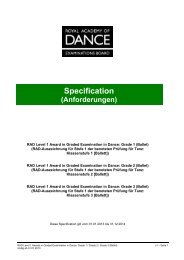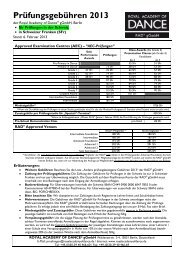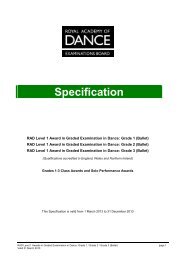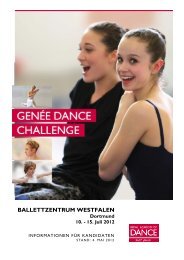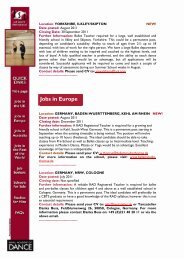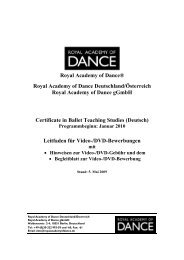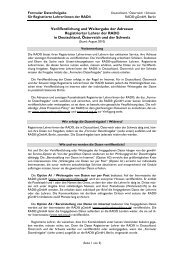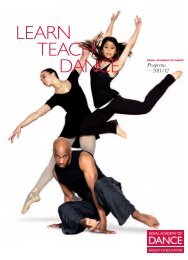Grades 1-3 Course Guidelines for Teachers - Royal Academy of ...
Grades 1-3 Course Guidelines for Teachers - Royal Academy of ...
Grades 1-3 Course Guidelines for Teachers - Royal Academy of ...
You also want an ePaper? Increase the reach of your titles
YUMPU automatically turns print PDFs into web optimized ePapers that Google loves.
<strong>Grades</strong> 1-3<br />
<strong>Course</strong> <strong>Guidelines</strong><br />
<strong>for</strong><br />
<strong>Teachers</strong><br />
Effective from January 2012<br />
A charity registered in England and Wales No 312826
Statement to applicants:<br />
All teachers’ courses, including syllabus courses such as this one, have an intrinsic<br />
value: they may <strong>for</strong>m part <strong>of</strong> an Accreditation <strong>of</strong> Prior Experiential Learning (APEL)<br />
portfolio, which could lead to exemption from future learning on <strong>for</strong>mal programmes<br />
<strong>of</strong> study. Looking <strong>for</strong>ward, the RAD will launch its Continuing Pr<strong>of</strong>essional<br />
Development (CPD) scheme in July 2013. From 1 July 2013 all RAD CPD activities<br />
will have an attached value - stated in either ‘credits’ (in line with more <strong>for</strong>mal<br />
learning) or ‘hours’ (in line with more practical / experiential learning). In the<br />
meantime, the current courses do not carry any ‘bankable’ credits or hours against<br />
future mandatory CPD requirements.<br />
Published by the <strong>Royal</strong> <strong>Academy</strong> <strong>of</strong> Dance<br />
A charity registered in England and Wales No 312826<br />
36 Battersea Square<br />
London SW11 3RA<br />
United Kingdom<br />
www.rad.org.uk<br />
© Copyright <strong>Royal</strong> <strong>Academy</strong> <strong>of</strong> Dance 2011<br />
All rights reserved<br />
Errors and omissions accepted<br />
Correct at time <strong>of</strong> publication<br />
ROYAL ACADEMY OF DANCE, RAD, RAD PRE-PRIMARY IN DANCE and RAD<br />
PRIMARY IN DANCE are registered trademarks® <strong>of</strong> the <strong>Royal</strong> <strong>Academy</strong> <strong>of</strong> Dance.<br />
RAD INTERMEDIATE FOUNDATION, RAD INTERMEDIATE, RAD CLASS AWARD,<br />
RAD SOLO PERFORMANCE AWARD and CBTS are unregistered trademarks <strong>of</strong><br />
the <strong>Royal</strong> <strong>Academy</strong> <strong>of</strong> Dance. The use or misuse <strong>of</strong> the trademarks or any other<br />
content <strong>of</strong> this publication, without prior written permission from the <strong>Royal</strong> <strong>Academy</strong><br />
<strong>of</strong> Dance, is strictly prohibited.
CONTENTS<br />
1 COURSE AIMS 4<br />
2 COURSE CONTENT 5<br />
3 SYLLABUS OVERVIEW 7<br />
4 SYLLABUS AIMS 8<br />
5 LEARNING<br />
OUTCOMES<br />
6 DEFINITION OF<br />
TERMS USED IN THE<br />
MARKSCHEME<br />
7 ASSESSMENT<br />
FORMATS<br />
8<br />
11<br />
13<br />
8 RESOURCES 15
1. <strong>Course</strong> Aims<br />
The Grade1-3 courses are designed to:<br />
<br />
<br />
<br />
<br />
Provide an overview <strong>of</strong> the three new syllabi launched in January 2012 and<br />
equip teachers with a secure base from which they can expand and develop<br />
their knowledge in relation to the syllabus content<br />
Exemplify the required movements as notated in “The Foundations <strong>of</strong><br />
Classical Ballet Technique” book<br />
Clarify the process, methodology, music and development <strong>of</strong> the vocabulary<br />
and choreography found in the syllabus<br />
Provide an opportunity <strong>for</strong> teachers to understand the Marking Scheme and<br />
how these apply to the preparation <strong>of</strong> students <strong>for</strong> assessment:<br />
Examinations, Class Awards and Solo Per<strong>for</strong>mance Awards<br />
2. <strong>Course</strong> Content<br />
The course is three days long with each day lasting seven hours (inclusive <strong>of</strong> 1 hour<br />
lunch).<br />
The RAD recognises that some teachers may only teach an individual Grade, but as<br />
some <strong>of</strong> the concepts apply equally to all <strong>Grades</strong>, and the content <strong>of</strong> <strong>Grades</strong> 1–3<br />
increases progressively, the course does not naturally lend itself to a day per Grade.<br />
Over the three days the course will cover:<br />
<br />
<br />
Aims <strong>of</strong> the syllabi<br />
Learning outcomes and assessment criteria<br />
Choreographic content <strong>Grades</strong> 1-3<br />
<br />
<br />
<br />
<strong>Guidelines</strong> on how to further develop technique, artistry, musicality and<br />
creativity in students in relation to the syllabi content<br />
Teaching methods<br />
Advice on preparation and procedures <strong>for</strong> <strong>Grades</strong> 1-3 Examinations, Class<br />
Awards and Solo Per<strong>for</strong>mance Awards<br />
3. Syllabus Overview<br />
As with the current syllabus, the new work is not a training programme but a<br />
comprehensive examination syllabus; ie. a staged series <strong>of</strong> assessments. The<br />
underlying philosophy <strong>of</strong> these levels is to expand upon the foundations nurtured in<br />
Pre-Primary and Primary in Dance, providing students and teachers with a sequential<br />
syllabus that will promote a developmentally appropriate and sound technique <strong>for</strong><br />
ballet.<br />
As with Pre-Primary in Dance and Primary in Dance, <strong>Grades</strong> 1-3 will promote ‘feeling<br />
be<strong>for</strong>e <strong>for</strong>m’ and advocate the creation <strong>of</strong> learning environments that are open,<br />
dynamic and empowering. The focus will be on identifying the necessary skills that<br />
underpin secure technique, while continuing to nurture the students’ awareness <strong>of</strong><br />
artistry and dynamics. Musically inspired exercises and dances will motivate students<br />
to acquire a well rounded understanding <strong>of</strong> ballet and character and promote joy in<br />
movement, sense <strong>of</strong> dance and per<strong>for</strong>mance quality. The music <strong>for</strong> the syllabi is a<br />
glorious collection <strong>of</strong> three centuries <strong>of</strong> dance music, including recordings made<br />
exclusively <strong>for</strong> the RAD by the Orchestra <strong>of</strong> English National Ballet conducted by<br />
Gavin Sutherland.
4. Syllabus Aims<br />
The aims <strong>of</strong> the Graded Syllabus qualifications are to:<br />
<br />
<br />
<br />
<br />
<br />
<br />
<br />
<br />
promote the study <strong>of</strong> ballet and related dance disciplines as a leisure and/or<br />
vocational activity<br />
provide a means <strong>of</strong> measuring the acquisition <strong>of</strong> technical, musical and<br />
per<strong>for</strong>mance skills in ballet and related dance disciplines<br />
promote and encourage enjoyment <strong>of</strong> movement as a <strong>for</strong>m <strong>of</strong> physical<br />
exercise<br />
provide all children and young people, with an opportunity <strong>of</strong> experiencing<br />
dance accompanied by live and or recorded music<br />
encourage personal self-confidence and group awareness through the<br />
experience <strong>of</strong> dancing solo, in partners and in small groups<br />
aid the development <strong>of</strong> a general appreciation <strong>of</strong> music through dancing to<br />
various musical styles and rhythmic patterns<br />
motivate students by providing a series <strong>of</strong> clearly defined goals which have<br />
been structured to reflect the principles <strong>of</strong> safe dance practice<br />
provide teachers with a means by which to measure the individual progress <strong>of</strong><br />
their students.<br />
A course <strong>of</strong> study based on these qualifications is intended to provide students with:<br />
<br />
<br />
<br />
<br />
<br />
an increasing ability to demonstrate practical knowledge <strong>of</strong> the dance<br />
disciplines <strong>of</strong> ballet and character<br />
a graduated measure <strong>of</strong> attainment against specific criteria<br />
increasing self-confidence through the learning, memorising and per<strong>for</strong>ming<br />
<strong>of</strong> prescribed sequences <strong>of</strong> movement, studies and dances<br />
an awareness and understanding <strong>of</strong> working with others<br />
an appreciation, through practical experience, <strong>of</strong> contrasting dance disciplines<br />
with their accompanying music.<br />
5. Learning Outcomes<br />
A candidate, who has successfully completed a course <strong>of</strong> study based on <strong>Grades</strong> 1-3<br />
will be able to:<br />
Technique<br />
demonstrate knowledge and understanding <strong>of</strong> the fundamental and relevant<br />
technique required at Level 1<br />
<br />
<br />
<br />
<br />
demonstrate co-ordination, control and accuracy in a range <strong>of</strong> sequences<br />
per<strong>for</strong>m with an awareness <strong>of</strong> line<br />
per<strong>for</strong>m with spatial awareness <strong>of</strong> the body in travelling movements and<br />
turning actions<br />
demonstrate an awareness <strong>of</strong> the appropriate dynamic values in the<br />
per<strong>for</strong>mance <strong>of</strong> the vocabulary<br />
Music<br />
<br />
per<strong>for</strong>m with correct and accurate timing and appropriate response to the<br />
music
Per<strong>for</strong>mance<br />
<br />
per<strong>for</strong>m with expression and communication.<br />
In the examination, candidates will be assessed on their ability to:<br />
<br />
<br />
<br />
<br />
per<strong>for</strong>m a series <strong>of</strong> prepared ballet exercises which require the ability to<br />
demonstrate secure posture, correct weight placement, co-ordination <strong>of</strong> the<br />
whole body, control, line, spatial awareness and dynamic values<br />
dance, throughout the examination, in time to the music and show<br />
responsiveness to the music<br />
dance, throughout the examination, with expression and communication<br />
per<strong>for</strong>m two Dances which require the candidate to demonstrate all the above<br />
aspects <strong>of</strong> Technique, Music and Per<strong>for</strong>mance.<br />
In progressing through these Level 1 qualifications, candidates are expected to<br />
demonstrate an increasing vocabulary <strong>of</strong> steps, and an increasing awareness and<br />
mastery <strong>of</strong> dance technique. Candidates are expected to demonstrate knowledge <strong>of</strong><br />
vocabulary as defined by the syllabus content. An understanding <strong>of</strong> technique is<br />
reflected in the ability to co-ordinate movements to produce combinations <strong>of</strong> steps<br />
with appropriate quality <strong>of</strong> movement (ie. precision and control), within the range <strong>of</strong><br />
the candidates’ physical capacity.<br />
Candidates are required to communicate an increasing confidence in per<strong>for</strong>mance.<br />
They should be able to interpret music and display a developing sensitivity to musical<br />
content and style. Candidates' per<strong>for</strong>mances should communicate a developing<br />
spatial awareness, an ability to work with others, and responsiveness to an audience.<br />
6. Assessment Formats<br />
Examination Format<br />
Grade 1 Content<br />
Technique 1<br />
Warm up<br />
Legs and arms<br />
Technique 2<br />
Port de bras<br />
Demi-pliés<br />
Transfer <strong>of</strong> weight<br />
Walks<br />
Technique 3<br />
Sautés<br />
Petit jetés and spring points<br />
Galops<br />
Technique 4<br />
Springs<br />
Step hop and parallel assemblé<br />
Dance: A or B<br />
Character Dance: C or D<br />
Révérence<br />
Format (with four candidates)<br />
all together<br />
two at a time<br />
all together<br />
all together<br />
two at a time<br />
two at a time continuously<br />
all together<br />
two at a time<br />
two at a time or all together twice through<br />
two at a time<br />
one at a time continuously<br />
one at a time<br />
one at a time<br />
all together
Grade 2 Content<br />
Technique 1<br />
Pliés<br />
Battements tendus<br />
Preparation <strong>for</strong> grands battements<br />
Technique 2<br />
Port de bras<br />
Fondus<br />
Transfer <strong>of</strong> weight<br />
Adage<br />
Technique 3<br />
Sautés and soubresauts<br />
Echappés sautés and petits jetés<br />
Galops<br />
Technique 4<br />
Turns and parallel assemblés<br />
Grand allegro<br />
Dance: A or B<br />
Character Dance: C or D<br />
Révérence<br />
Format (with four candidates)<br />
all together<br />
all together<br />
all together<br />
two at a time<br />
two at a time continuously<br />
two at a time or all together twice through<br />
two at a time<br />
two at a time<br />
two at a time<br />
two at a time or all together twice through<br />
one at a time continuously<br />
two at a time continuously<br />
one at a time<br />
one at a time<br />
all together<br />
Grade 3 Content<br />
Technique 1<br />
Pliés<br />
Battements tendus and battements glissés<br />
Battements fondus and développés devant<br />
Grands battements A – devant OR Grands<br />
battements B – second and derrière<br />
Technique 2<br />
Port de bras<br />
Ronds de jambe à terre<br />
Transfer <strong>of</strong> weight<br />
Adage<br />
Technique 3<br />
Sautés and changements<br />
Glissades, sissonnes and assemblés<br />
Posés and temps levés<br />
Technique 4<br />
Turns<br />
Grand allegro<br />
Dance: A, B or C<br />
Character Dance: D or E<br />
Format (with four candidates)<br />
all together<br />
all together<br />
all together<br />
all together<br />
two at a time<br />
all together<br />
two at a time or all together twice through<br />
two at a time<br />
two at a time<br />
two at a time<br />
two at a time<br />
one at a time continuously<br />
one at a time continuously<br />
one at a time<br />
one at a time
Class Award Format<br />
The content <strong>for</strong> Class Awards is the same as <strong>for</strong> Graded Examinations (see above)<br />
except that candidates present one dance rather than two. Class Awards are<br />
conducted by the teacher or an assistant.<br />
<strong>Teachers</strong> should arrange candidates in groupings that are appropriate <strong>for</strong> the studio<br />
space, allow the Examiner to clearly see all the candidates and fit within the allocated<br />
time frame.<br />
The Dance should be shown two at a time and any continuous diagonals two by two.<br />
Solo Per<strong>for</strong>mance Award Format<br />
Candidates can be entered in sets <strong>of</strong> up to four.<br />
Candidates are required to present three dances, each shown as a solo. Two <strong>of</strong><br />
these must be taken from the corresponding Graded Examination syllabus. The third<br />
dance may be either:<br />
(a) also taken from the corresponding graded syllabus; or<br />
(b) a free choice, in any dance genre or style.<br />
7. Resources<br />
Word notes / Benesh notation<br />
Code<br />
100G123<br />
Description<br />
<strong>Grades</strong> 1-3: Set Exercises and Dances (includes full word notes and<br />
Benesh notation <strong>for</strong> all examination content)<br />
Music<br />
Code<br />
200G123<br />
300G123<br />
Description<br />
<strong>Grades</strong> 1-3: Printed music: Set Exercises and Dances<br />
<strong>Grades</strong> 1-3: Set <strong>of</strong> 3 CDs, each containing orchestral (<strong>for</strong> examination)<br />
and piano (<strong>for</strong> rehearsal) versions <strong>of</strong> the music.<br />
DVD<br />
Code<br />
330G123<br />
Description<br />
<strong>Grades</strong> 1-3: Set Exercises and Dances




